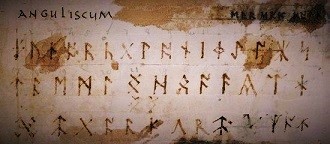 All types of Germanic runic writing are basically kindred and go back to the Common Germanic Elder Futhark. One may be certain that these ancient runes had names. Alas, no rune-master of the Common Germanic period either left us a list of names for the Elder Futhark or explained what these names meant. Therefore modern expositions of the original rune-names and rune-meanings are more or less daring reconstructions. There are several sources that allow us to speculate about the Common Germanic names of runes:
All types of Germanic runic writing are basically kindred and go back to the Common Germanic Elder Futhark. One may be certain that these ancient runes had names. Alas, no rune-master of the Common Germanic period either left us a list of names for the Elder Futhark or explained what these names meant. Therefore modern expositions of the original rune-names and rune-meanings are more or less daring reconstructions. There are several sources that allow us to speculate about the Common Germanic names of runes:
- Anglo-Saxon runica manuscripta (the earliest late 8th century)
- Abecedarium Nordmannicum (9th century)
- Letter-names of the Gothic alphabet (recorded in the 10th century)
- Anglo-Saxon Rune Poem (end of the 10th century)
- Norwegian Rune Poem (late 12th century)
- Icelandic Rune Poem (15th century)
As one may see, the sources are rather late. Each of them is a witness of the contemporary runic tradition as it existed in a certain locality with respect to the number of runes, their meanings and names. Runica mansucripta are insular and continental manuscripts containing listings of Anglo-Saxon runes with more or less accurate roman equivalents and sometimes rune-names. One should remember that the manuscript tradition is somewhat different from the epigraphical one (whether or not they should be treated separately or combined as supplementary is not certain). Abecedarium Nordmannicum is a list of runes with short explanatory notes found in the Codex Sangallensis 878 that probably comes from Fulda. It is written in Old Saxon with traces of Anglo-Saxon influence. Names of Gothic letters are known from ms 795 from Vienna, National Library. The language of these letter-names is notoriously different from that of Ulfila’s translation of the Bible. Many researchers doubt whether this material may be relied upon. Anglo-Saxon Rune Poem from British Library MS Cotton Otho B.x has 29 stanzas of alliterative verse and is a very detailed account of the names and meanings of runes. Its Norwegian and Icelandic counterparts are shorter since they describe the 16-runes Younger Futhark and were recorded considerably later.
Photo: Anglo-Saxon runic alphabet as presented in Codex Sangallensis 878 (9th century). Public domain.
